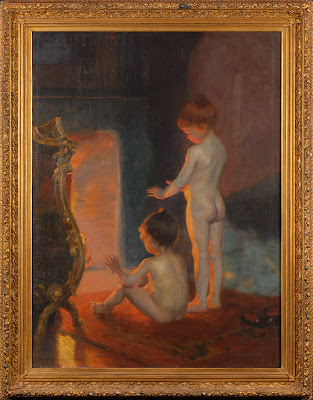With his little dog, too, a jug named Buster, who I am going to steal.
We started off at the AGO and their new Patti Smith gallery, which was crap, and their new Josef Sudek gallery which was amazing.
Sudek had one arm, and did things like make panoramic film himself. He also looked like hell, and he did amazing work, documenting Prague in photography better than anyone else.
A plaque at the exhibition contained a quote from a 1933 reviewer: "[Sudek's] greatest efforts are achieved when he 'sculpts' with light and shadow... These works have a purpose and are proof of his enormous love of photography."
This shot from 1948 is called "Leading to the Lair of the Cunning Little Vixen".
I love how he's so unafraid of shadow.
This shot called "In the Magic Garden (Hat on Bench)" I found so inviting, I wanted to take a book and read under the huge canopy.
This one from 1930 shows again his mastery of shadow.
The exhibit was quite, quite large. A career retrospective really, and almost all of it worth checking out.
It was nice to have Linda there, my dad's partner, as she volunteers at the AGO. When we got to the amazing "The Academy" by Kent Monkman, she was able to give us a little history around it.
I couldn't find a better photo on the net than the one I took:
The piece was commissioned by the AGO and uses some of their art in it, including one of my favourites, "After the Bath" by Paul Peel. Monkman says:
Immediately to the right of the West figure sits two children in front of a small fire reference Paul Peel’s After the Bath (1890). Within The Academy, they are depicted as putti and grouped with a coyote that is representative of the Cree trickster figure, Weeseegachak. This arrangement visualizes an intersection between European and Aboriginal mythologies. Putti, in classic times, were often depicted participating in bacchic/pagan rites.
Some of the other works are located around the painting, but many are not. Two very close are "Portrait of William Henry Boulton" by George Theodore Berthon:
And "Portrait of Mrs. William Henry Berthon (Harriette)", both from 1846. Apparently Boulton founded the AGO.Of these Monkman says:
My alter ego, Miss Chief, is pictured in the drag of Harriette Dixon Bouton, represented in The Academy in a double portrait of the Grange matriarch and her husband, Mr. William Henry Boulton. As a Bostonian, Harriette played the role of outsider and principal witness to much of The Grange’s history; Miss Chief reprises this role in The Academy, while continuing her exploration of the European male. Miss Chief is positioned in the figuration of Monsiau’s rendering of Zeuxis, as she is seen extending a circular braid of sweetgrass towards the European male models whom she draws inspiration for a pictographic image, chalked out on her canvas. The chalk outlines refer to the chalk drawing of an Aboriginal Dandy that Catlin began but could not finish, leaving the Aboriginal Dandies doomed forever to obscurity.
Mr. Boulton is found seated behind Miss Chief, playfully kicking up her over-skirt and crinoline. Unable to see her face, perhaps he is unaware that it is a Berdashe masquerading as his wife. Resting closely near Mr. Boulton’s other foot is an intricately decorated clay pot. The implication of the clay pot invokes a historical New Mexican tribe member -We’wha (1849-1896). A Zuni Indian, an Ihamana (man/woman or Berdashe), We’wha was a prominent figure of the tribe and worked as both a potter and priest and achieved high-ranking status through religious ceremonies.
Then on to less good paintings and home!
Great day!















No comments:
Post a Comment